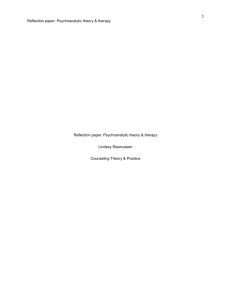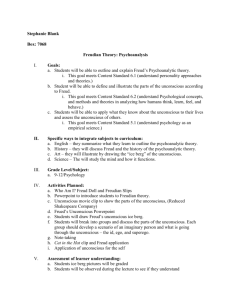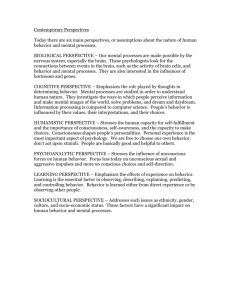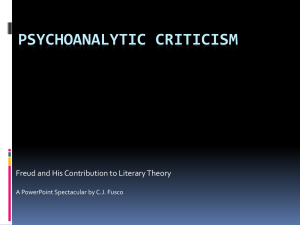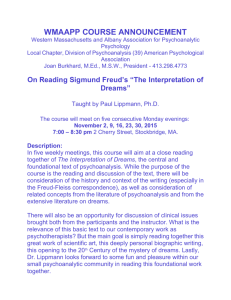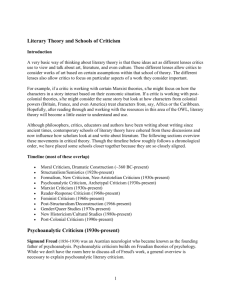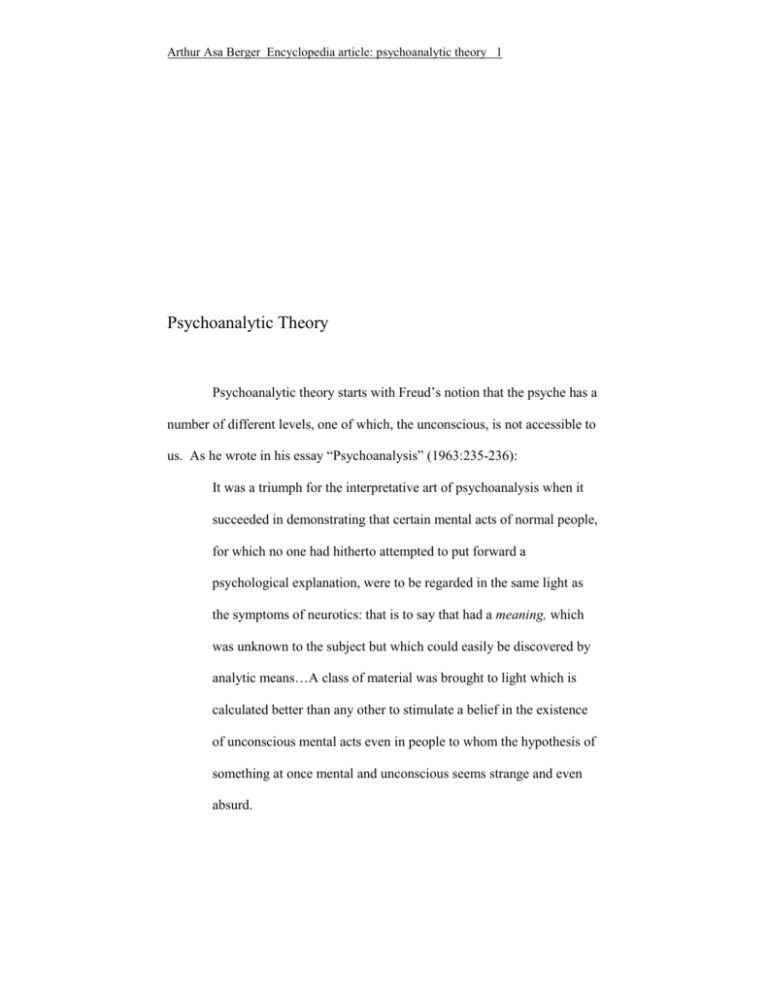
Arthur Asa Berger Encyclopedia article: psychoanalytic theory 1
Psychoanalytic Theory
Psychoanalytic theory starts with Freud’s notion that the psyche has a
number of different levels, one of which, the unconscious, is not accessible to
us. As he wrote in his essay “Psychoanalysis” (1963:235-236):
It was a triumph for the interpretative art of psychoanalysis when it
succeeded in demonstrating that certain mental acts of normal people,
for which no one had hitherto attempted to put forward a
psychological explanation, were to be regarded in the same light as
the symptoms of neurotics: that is to say that had a meaning, which
was unknown to the subject but which could easily be discovered by
analytic means…A class of material was brought to light which is
calculated better than any other to stimulate a belief in the existence
of unconscious mental acts even in people to whom the hypothesis of
something at once mental and unconscious seems strange and even
absurd.
Arthur Asa Berger Encyclopedia article: psychoanalytic theory 2
Although we may think we are aware of everything that is going on in our
minds, we are mistaken, for, as Freud explained, there are “unconscious
mental acts” that we do not recognize.
A convenient way to understand the human psyche is to imagine it as
being like an iceberg. The part of the iceberg that floats above the water is
what we call consciousness. Just below the water line, there are a few feet of
the iceberg we can dimly make out—that is what we call the pre-conscious.
We do not ordinarily think about the contents of the pre-conscious but if we
want to, we can become aware of what is in our preconscious. Then there is
the part of the iceberg that we cannot see, which is most of the iceberg, that is
masked in darkness, which is what Freud called the unconscious.
The iceberg analogy suggests that most of what is in our minds in not
accessible to us, but this unconscious is important because in many ways it
shapes our behavior. We are not in complete control of our behavior and are
vulnerable to various emotional and irrational appeals that often shape our
actions. Freud called this approach to the human psyche his topographic
hypothesis.
He later elaborated another hypothesis about the human mind, his
structural hypothesis. In this hypothesis, there is a continual battle going on
in our minds between its three elements—the id, the ego, and the superego.
Freud described the id in his New Introductory Lectures in Psychoanalysis as
follows (quoted in Hinsie & Campbell, 1970:372):
We can come nearer to the id with images, and call it chaos, a
cauldron of seething excitement. We suppose that is somewhere in
direct contact with somatic processes, and takes over from them
instinctual needs and gives them mental expression…These instincts
Arthur Asa Berger Encyclopedia article: psychoanalytic theory 3
fill it with energy but is has no organization and no unified will, only
an impulsion to obtain satisfaction for the instinctual needs, in
accordance with the pleasure-principle.
If this “cauldron of seething of seething excitement” dominates us, we have a
great deal of energy but cannot use it effectively because we are always being
drawn by a desire to take care of our instinctual needs.
Opposing the id is the superego, which can be described as
conscience and the way our personality functions morally. In An Elementary
Textbook of Psychoanalysis, Charles Brenner describes the superego as
follows (1974: 111-112):
1. the approval or disapproval of actions and wishes on the grounds of
rectitude. 2. critical self-observation. 3. self-punishment. 4. the
demand for reparation or repentance of wrong-doing. 5. self-praise
or self-love as a reward for virtuous or desirable thoughts and
actions. Contrary to the ordinary meaning of “conscience,” however,
we understand that the functions of the superego are often largely or
completely unconscious.
Thus we find two elements in the human psyche opposed to one another. The
id seeks gratification and has great energy, but it cannot be allowed to
dominate our behavior because we are social animals and must submit to the
demands of civilization upon us—demands which often cause us considerable
mental anguish. On the other hand, if the super-ego dominates, we are so full
of doubt and guilt that we are paralyzed by guilt and doubt.
This is where the ego comes in. The ego is that element of our
psyches that mediates between the conflicting demands of the id and the
superego. The ego tests reality and stores up experiences in the memory, in
Arthur Asa Berger Encyclopedia article: psychoanalytic theory 4
an effort to find a way to balance the demands of the id and superego and
allow people to be free of neurotic compulsions based on overly powerful id
or superego elements in the psyche. It seems to harness the energy of the id in
socially constructive ways by using the superego to moderate id behavior.
Many psychological problems people face are caused by either an overly
powerful id or superego.
The ego uses a number of different defense mechanisms to find ways
to control id-based impulses and superego-based anxieties and guilt. These
defense mechanisms operate at the unconscious level. Some of the more
important defense mechanisms are:
Ambivalence. A feeling of both love and hatred toward some person
at the same time.
Avoidance. A refusal to pay attention to subjects that are disturbing
because they are connected to unconscious aggressive or sexual impulses.
Denial. A refusal to accept the reality of something by blocking it
from consciousness.
Fixation. An obsessive preoccupation with or attachment to
something or someone.
Projection. A denial of negative and hostile feelings in oneself by
attributing them to someone else.
Rationalization. A means of excusing one’s behavior by offering
reasons or excuses.
Reaction formation. A situation that occurs when ambivalent feelings
creates problems and which is dealt with by suppressing one element and
overemphasizing the other, its opposite.
Arthur Asa Berger Encyclopedia article: psychoanalytic theory 5
Regression. An individual’s return to an earlier stage in development
when confronted with stressful or anxiety provoking situations.
Repression. A barring from consciousness of wishes, memories,
desires that are derived from the unconscious. Repression is considered the
most basic defense mechanism.
Sublimation. A transferring of sexual impulses and other desires and
impulses into other kinds of behavior, such as writing, painting and other
kinds of creative arts.
Suppression. A voluntary attempt to put out of mind and
consciousness something we find upsetting and distasteful. Suppression is
voluntary, unlike repression which works at the unconscious level.
Suppression is considered the second most important defense mechanism.
These defense mechanisms are of interest to media and
communication scholars, as well as therapists, since they can be found in so
many narratives and other texts found in the media. They appear in these
works because they are in the unconscious the people who create them.
We must recall that Freud called psychoanalysis an “interpretative
art.” One of the ways it can be applied is by using psychoanalytic theories to
deal with symbolic behavior. A symbol is something that stands for
something else. A symbol can stand for institutions, ideas, beliefs, values,
and wishes. In psychoanalytic theory, symbols are important because they are
often used to disguise aggressive wishes and sexual desires, and, in the case of
dreams, prevent our dream censors from waking us if the sexual content of
our dreams becomes too evident.
As Freud points out in his masterwork, The Interpretation of Dreams,
symbolism is all pervasive in human life. As he writes (1900/1965:386):
Arthur Asa Berger Encyclopedia article: psychoanalytic theory 6
Symbolism is not peculiar to dreams, but is characteristic of
unconscious ideation, in particular, among people, and is to be found
in folklore, and in popular myths, legends, linguistic idioms,
proverbial wisdom and current jokes, to a more complete extent than
in dreams.
In his discussion of dreams, that follows a bit later in his book, he offers some
typical examples of the symbolism found in dreams. After offering some
qualifications for his ideas he writes (1900/1965:389):
The Emperor and Empress (or the King and Queen) as a rule really
represent the dreamer himself or herself…All elongated objects, such
as sticks, tree-trunks and umbrellas may stand for the male organ—as
well as all long, sharp weapons such as knives, daggers and
pikes…Boxes, cases, chests, cupboards and ovens represent the
uterus, and also hollow objects, ships, and vessels of all kinds.
Rooms in dreams are usually women.
From this list we can see that many objects have a hidden, symbolic and often
sexual significance. In the pages that follow Freud deals with other symbols,
mentioning that snakes are an important phallic symbol. This notion of
objects having a sexually symbolic nature often strike people as ridiculous
and absurd. We must recognize that these symbols are operating at the
unconscious level and are often tied to myths and legends. Freud himself said
“sometimes a cigar is only a cigar,” in reference to the notion that symbolic
objects have a sexual dimension, but this quotation suggests, also, that
sometimes a cigar isn’t only a cigar.
There are two ways that the sexual content in dreams is disguised,
according to Freud. The first way is by condensation, in which parts of
Arthur Asa Berger Encyclopedia article: psychoanalytic theory 7
different sexual symbols are combined into one that disguises the dream’s
sexual content and thus fools the dream censor. The other, displacement,
involves the substitution of one image for another which is associated with it
but which is not explicitly sexual, thus evading the dream censor, which
wakes us if there is too overtly a sexual dimension to our dreams.
Dreams are a very controversial subject and one about which theorists
continually argue. The Freudian position is described by an important
psychoanalytic writer Erich Fromm in his book The Forgotten Language: An
introduction to the understanding of dreams, fairy tales and myths. In this
book he writes (1957:67):
Dreams are understood to be the hallucinatory fulfillment of irrational
wishes and particularly sexual wishes which have originated in our
early childhood and have not been fully transformed into reaction
formations or sublimations. These wishes are expressed as being
fulfilled when our conscious control is weakened, as is the case in
sleep.
This notion, that dreams are a means of satisfying frustrated desires and thus a
form of wish-fulfillment is at the heat of the controversy over the Freudian
theory of dreams.
Another Freudian theory that many people find difficult to accept
involves his theory of infant sexuality and, in particular, his notion of the
Oedipus Complex, which was named after the myth of Oedipus. In this myth,
an oracle prophesizes that Laius, the king of Thebes, will be killed by his son.
When Laius’s wife Jocasta gives birth to a son, Oedipus, Laius arranges to
have the son left on a mountain peak to die. He is unaware that Oedipus has
Arthur Asa Berger Encyclopedia article: psychoanalytic theory 8
been rescued and taken to a king, Polybus, in Corinth, who raises him as his
son.
When Oedipus hears that a prophecy says he will kill his father,
Oedipus leaves Corinth to spare Polybus. On the road to Thebes he meets
Laius at a crossroads, they get into a fight, and Oedipus kills Laius. He then
goes to Thebes which is under a plague from a monster, the Sphynx, which
has the face of a woman and the body of a lion. The Sphynx devours anyone
who cannot answer this riddle: “What creature goes on four feet in the
morning, two feet at noon, and three feet in the evening?” Oedipus answers
“A man, who crawls as a child, walks on two feet in the prime of his life, and
needs a cane to walk in old age.” When he answers the riddle correctly, the
Sphynx kills itself and Oedipus is welcomed into Thebes as its savior. He is
made king, marries Jocasta, the wife of the former king (not knowing that she
is his mother) and they have two children. Later Thebes is visited by another
plague. Tiresias, a blind prophet, is sent to an oracle which says that the
murderer of Laius must be punished for Thebes to be rid of the plague. When
Oedipus discovers that he is the one who killed Laius, his real father, and that
he has married his mother, he blinds himself and Jocasta commits suicide.
This myth is a paradigmatic one that Freud believed explained the
process of development in all children. There is, in this story and Freud
believed in the lives of all children, a hostility toward the parent of the same
sex and an attraction to the parent of the opposite sex that eventually
manifests itself. As a rule, children overcome their Oedipus complex and can
lead normal lives, but those who cannot do so become neurotic. Freud argued
that the Oedipus Complex is the core of all neuroses.
Arthur Asa Berger Encyclopedia article: psychoanalytic theory 9
Freud wrote about his discovery of the Oedipus Complex in a letter to
a friend, Wilhelm Fleiss on October 15, 1897 (quoted in Martin Grotjahn:
Beyond Laughter: Humor and the Subconscious, 1966:84):
Being entirely honest with oneself if a good exercise. Only one idea
of general value has occurred to me. I have found love of the mother
and jealousy of the father in my own case too, and now believe it to
be a general phenomena of early childhood…If that is the case, the
gripping power of Oedipus Rex, in spite of all the rational objections
to the inexorable fate that the story presupposes, becomes
intelligible…Our feelings rise against any arbitrary individual
fate…but the Greek myth seizes on a compulsion which everyone
recognizes because he has felt traces of it in himself. Every member
of the audience was once a budding Oedipus in fantasy, and this
dream-fulfillment played out in reality causes everyone to recoil in
horror, with the full measure of repression which separates his
infantile from his present state.
In this letter Freud adds that he thinks that there is a strong Oedipal
component to Hamlet though he isn’t talking about Shakespeare’s conscious
intentions but unconscious feelings of kinship with his tragic hero.
This brings us to our final consideration, the role that psychoanalytic
theory plays in the study of mass mediated and other kinds of texts. The
English critic Simon Lesser, points out in his book Fiction and the
Unconscious, that psychoanalysis investigates the same themes that our
greatest fiction writers dealt with, namely (1957:15) “the emotional,
unconscious or only partly comprehended bases of our behavior.” It is
psychoanalytic theory that offers us, Lesser adds, systematic and well
Arthur Asa Berger Encyclopedia article: psychoanalytic theory 10
validated knowledge about the non-rational and in some cases irrational
forces that shape our behavior, areas which before the development of
psychoanalytic theory, were no accessible to criticism.
Psychoanalytic theory has been used by Bruno Bettelheim to
investigate fairy tales, by Erich Fromm to study myths and dreams, by Ernest
Jones to analyze Hamlet and by many other writers to interpret novels, films,
humor, television shows and other forms of the elite arts and popular culture.
There are, of course, other theorists who deal with the human psyche, such as
Carl Jung and Alfred Adler, who offer different insights into the human
psyche and personality, but it is Sigmund Freud and his followers who have
defined psychoanalytic theory as we commonly know it.
Bibliography
Berger, Arthur Asa. 2000.
The Hamlet Case: The Murders at the MLA.
New York: XLibris.
Bettelheim, Bruno. 1977
The Uses of Enchantment: The Meaning and Importance of Fairly Tales.
New York: Vintage
Brenner, Charles. 1974.
An Elementary Textbook of Psychoanalysis.
Garden City, NY: Doubleday
Arthur Asa Berger Encyclopedia article: psychoanalytic theory 11
Freud, Sigmund. 1901/1965.
The Interpretation of Dreams.
New York: Avon
Fromm, Erich. 1957
The Forgotten Language: An Introduction to the Understanding of Dreams,
Fairy Tales and Myth.
New York: Grove
Grotjahn, Martin. 1966
Beyond Laughter: Humor and the Subconscious.
New York: McGraw-Hill.
Hinsie, L.E. and R. J. Campbell. 1970
Psychiatric Dictionary.
New York: Oxford University Press.
Jones, Ernest. 1949
Hamlet and Oedipus.
New York: W.W. Norton
Lesser, Simon O. 1957.
Fiction and the Unconscious
Boston: Beacon
Arthur Asa Berger Encyclopedia article: psychoanalytic theory 12
Arthur Asa Berger Encyclopedia article: psychoanalytic theory 13
Arthur Asa Berger Encyclopedia article: psychoanalytic theory 14
Arthur Asa Berger Encyclopedia article: psychoanalytic theory 15



